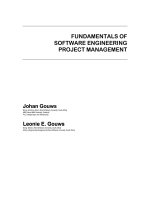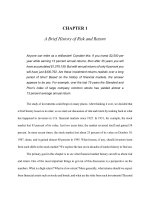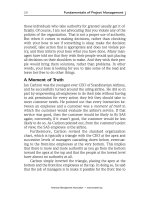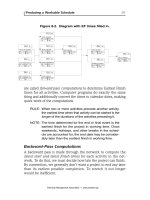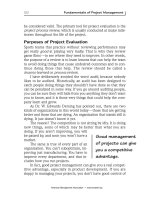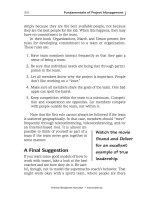fundamentals of investments, charles j corrado-mcgraw-hill-isbn 0072976357
Bạn đang xem bản rút gọn của tài liệu. Xem và tải ngay bản đầy đủ của tài liệu tại đây (10.13 MB, 1,067 trang )
CHAPTER 1
A Brief History of Risk and Return
Anyone can retire as a millionaire! Consider this: If you invest $2,500 per
year while earning 12 percent annual returns, then after 35 years you will
have accumulated $1,079,159. But with annual returns of only 8 percent you
will have just $430,792. Are these investment returns realistic over a long
period of time? Based on the history of financial markets, the answer
appears to be yes. For example, over the last 75 years the Standard and
Poor’s index of large company common stocks has yielded almost a
13 percent average annual return.
The study of investments could begin in many places. After thinking it over, we decided that
a brief history lesson is in order, so we start our discussion of risk and return by looking back at what
has happened to investors in U.S. financial markets since 1925. In 1931, for example, the stock
market lost 43 percent of its value. Just two years later, the market reversed itself and gained 54
percent. In more recent times, the stock market lost about 25 percent of its value on October 19,
1987, alone, and it gained almost 40 percent in 1995. What lessons, if any, should investors learn
from such shifts in the stock market? We explore the last seven decades of market history to find out.
The primary goal in this chapter is to see what financial market history can tell us about risk
and return. One of the most important things to get out of this discussion is a perspective on the
numbers. What is a high return? What is a low return? More generally, what returns should we expect
from financial assets such as stocks and bonds, and what are the risks from such investments? Beyond
2 Chapter 1
this, we hope that by studying what did happen in the past, we will at least gain some insight into
what can happen in the future.
The history of risk and return is made day by day in global financial markets. The internet is
an excellent source of information on financial markets. Visit our website (at
www.mhhe.com/~finance /cjlinks) for suggestions on where to find information on recent financial
market events.
Not everyone agrees on the value of studying history. On the one hand, there is philosopher
George Santayana's famous comment, “Those who do not remember the past are condemned to
repeat it.” On the other hand, there is industrialist Henry Ford's equally famous comment, “History
is more or less bunk.” These extremes aside, perhaps everyone would agree with Mark Twain who
observed, with remarkable foresight (and poor grammar), that “October. This is one of the peculiarly
dangerous months to speculate in stocks in. The others are July, January, September, April,
November, May, March, June, December, August, and February.”
Two key observations emerge from a study of financial market history. First, there is a reward
for bearing risk, and, at least on average, that reward has been substantial. That's the good news. The
bad news is that greater rewards are accompanied by greater risks. The fact that risk and return go
together is probably the single most important fact to understand about investments, and it is a point
to which we will return many times.
Risk and Return 3
1
As a practical matter, what is and what is not a capital gain (or loss) is determined by the Internal
Revenue Service. Even so, as is commonly done, we use these terms to refer to a change in value.
1.1 Returns
We wish to discuss historical returns on different types of financial assets. First, we need to
know how to compute the return from an investment. We will consider buying shares of stock in this
section, but the basic calculations are the same for any investment.
(marg. def. total dollar return The return on an investment measured in dollars that
accounts for all cash flows and capital gains or losses.)
Dollar Returns
If you buy an asset of any type, your gain (or loss) from that investment is called the return
on your investment. This return will usually have two components. First, you may receive some cash
directly while you own the investment. Second, the value of the asset you purchase may change. In
this case, you have a capital gain or capital loss on your investment.
1
To illustrate, suppose you purchased 100 shares of stock in Harley-Davidson on January 1.
At that time, Harley was selling for $37 per share, so your 100 shares cost you $3,700. At the end
of the year, you want to see how you did with your investment.
The first thing to consider is that over the year, a company may pay cash dividends to its
shareholders. As a stockholder in Harley, you are a part owner of the company, and you are entitled
to a portion of any money distributed. So, if Harley chooses to pay a dividend, you will receive some
cash for every share you own.
4 Chapter 1
In addition to the dividend, the other part of your return is the capital gain or loss on the
stock. This part arises from changes in the value of your investment. For example, consider these cash
flows:
Ending Stock Price
$40.33 $34.78
January 1
December 31
Dividend income
Capital gain or loss
$3,700
4,033
185
333
$3,700
3,478
185
-222
At the beginning of the year, on January 1, the stock is selling for $37 per share, and, as we calculated
above, your total outlay for 100 shares is $3,700. Over the year, Harley pays dividends of $1.85 per
share. By the end of the year, then, you received dividend income of
Dividend income = $1.85 × 100 = $185
Suppose that as of December 31, Harley was selling for $40.33, meaning that the value of your stock
increased by $3.33 per share. Your 100 shares are now worth $4,033, so you have a capital gain of
Capital gain = ($40.33 - $37) × 100 = $333
On the other hand, if the price had dropped to, say, $34.78, you would have a capital loss of
Capital loss = ($34.78 - $37) × 100 = -$222
Notice that a capital loss is the same thing as a negative capital gain.
The total dollar return on your investment is the sum of the dividend and the capital gain:
Total dollar return = Dividend income + Capital gain (or loss)
In our first example here, the total dollar return is thus given by
Total dollar return = $185 + $333 = $518
Risk and Return 5
Overall, between the dividends you received and the increase in the price of the stock, the value of
your investment increased from $3,700 to $3,700 + $518 = $4,218.
A common misconception often arises in this context. Suppose you hold on to your Harley-
Davidson stock and don't sell it at the end of the year. Should you still consider the capital gain as
part of your return? Isn't this only a “paper” gain and not really a cash gain if you don't sell it?
The answer to the first question is a strong yes, and the answer to the second is an equally
strong no. The capital gain is every bit as much a part of your return as the dividend, and you should
certainly count it as part of your return. That you decide to keep the stock and don't sell (you don't
“realize” the gain) is irrelevant because you could have converted it to cash if you had wanted to.
Whether you choose to do so is up to you.
After all, if you insist on converting your gain to cash, you could always sell the stock and
immediately reinvest by buying the stock back. There is no difference between doing this and just not
selling (assuming, of course, that there are no transaction costs or tax consequences from selling the
stock). Again, the point is that whether you actually cash out and buy pizzas (or whatever) or reinvest
by not selling doesn't affect the return you actually earn.
6 Chapter 1
(marg. def. total percent return The return on an investment measured as a percent
of the originally invested sum that accounts for all cash flows and capital gains or
losses.)
Percentage Returns
It is usually more convenient to summarize information about returns in percentage terms
than in dollar terms, because that way your return doesn't depend on how much you actually
invested. With percentage returns the question we want to answer is: How much do we get for each
dollar we invest?
To answer this question, let P
t
be the price of the stock at the beginning of the year and let
D
t+1
be the dividend paid on the stock during the year. The following cash flows are the same as those
shown earlier, except that we have now expressed everything on a per share basis:
Ending Stock Price
$40.33 $34.78
January 1
December 31
Dividend income
Capital gain or loss
$37.00
40.33
1.85
3.33
$37.00
34.78
1.85
-2.22
In our example, the price at the beginning of the year was $37 per share and the dividend paid
during the year on each share was $1.85. If we express this dividend as a percentage of the beginning
stock price, the result is the dividend yield:
Dividend yield = D
t+1
/ P
t
= $1.85 / $37 = .05 = 5%
This says that, for each dollar we invested, we received 5 cents in dividends.
Risk and Return 7
The second component of our percentage return is the capital gains yield. This yield is
calculated as the change in the price during the year (the capital gain) divided by the beginning price.
With the $40.33 ending price, we get:
Capital gains yield = (P
t+1
- P
t
) / P
t
= ($40.33 - $37) / $37
= $3.33 / $37 = .09 = 9%
This 9 percent yield means that for each dollar invested we got 9 cents in capital gains.
Putting it all together, per dollar invested, we get 5 cents in dividends and 9 cents in capital
gains for a total of 14 cents. Our total percentage return is 14 cents on the dollar, or 14 percent.
When a return is expressed on a percentage basis, we often refer to it as the rate of return on the
investment.
To check our calculations, notice that we invested $3,700 and ended up with $4,218. By what
percentage did our $3,700 increase? As we saw, we picked up $4,218 - $3,700 = $518. This is an
increase of $518 / $3,700, or 14 percent.
Example 1.1 Calculating Percentage Returns Suppose you buy some stock for $25 per share. After
one year, the price is $35 per share. During the year, you received a $2 dividend per share. What is
the dividend yield? The capital gains yield? The percentage return? If your total investment was
$1,000, how much do you have at the end of the year?
Your $2 dividend per share works out to a dividend yield of
Dividend yield = D
t+1
/ P
t
= $2 / $25
= 8%
8 Chapter 1
The per share capital gain is $10, so the capital gains yield is
Capital gains yield = (P
t+1
- P
t
) / P
t
= ($35 - $25) / $25
= $10 / $25
= 40%
The total percentage return is thus 8% + 40% = 48%.
If you had invested $1,000, you would have $1,480 at the end of the year. To check this, note
that your $1,000 would have bought you $1,000 / $25 = 40 shares. Your 40 shares would then have
paid you a total of 40 × $2 = $80 in cash dividends. Your $10 per share gain would give you a total
capital gain of $10 × 40 = $400. Add these together and you get $480, which is a 48 percent total
return on your $1,000 investment.
CHECK THIS
1.1a What are the two parts of total return?
1.1b Why are unrealized capital gains or losses included in the calculation of returns?
1.1c What is the difference between a dollar return and a percentage return? Why are percentage
returns usually more convenient?
1.2 The Historical Record
We now examine year-to-year historical rates of return on three important categories of
financial investments. These returns can be interpreted as what you would have earned if you had
invested in portfolios of the following asset categories:
1. Large capitalization stocks (large-caps). The large company stock
portfolio is the Standard and Poor’s index of the largest companies (in
terms of total market value of outstanding stock) in the United States.
This index is known as the S&P 500, since it contains 500 large
companies.
Risk and Return 9
Figure 1.1 about here
2. Long-term U.S. Treasury bonds. This is a portfolio of U.S.
government bonds with a 20-year life remaining until maturity.
3. U.S. Treasury bills. This a portfolio of Treasury bills (T-bills for short)
with a three-month investment life.
If you are now not entirely certain what these investments are, don't be overly concerned. We
will have much more to say about each in later chapters. For now, just take it as given that these are
some of the things that you could have put your money into in years gone by. In addition to the
year-to-year returns on these financial instruments, the year-to-year percentage changes in the
Consumer Price Index (CPI) are also computed. The CPI is a standard measure of consumer goods
price inflation.
A First Look
Before examining the different portfolio returns, we first take a look at the "big picture."
Figure 1.1 shows what happened to $1 invested in these three different portfolios at the beginning
of 1926 and held over the 72-year period ending in 1997.
To fit all the information on a single graph, some modification in scaling is used. As is
commonly done with financial time series, the vertical axis is scaled so that equal distances measure
equal percentage (as opposed to dollar) changes in value. Thus, the distance between $10 and $100
is the same as that between $100 and $1,000, since both distances represent the same 900 percent
increases.
10 Chapter 1
Figure 1.2 about here
Looking at Figure 1.1, we see that among these three asset categories the large-cap common
stock portfolio did the best. Every dollar invested in the S&P 500 index at the start of 1926 grew to
$1,659.03 at the end of 1997. At the other end of the return spectrum, the T-bond portfolio grew to
just $36.35, and the T-bill portfolio grew to only $17.43. This bond and bill performance is even less
impressive when we consider inflation over this period. As illustrated, the increase in the price level
was such that $9.01 was needed in 1997 just to replace the purchasing power of the original $1 in
1926. In other words, an investment of $9.01 in T-bonds (measured in today's dollars) grew to only
$36.35 over 72 years.
Given the historical record, why would any investor buy anything other than common stocks?
If you look closely at Figure 1.1, you will see the answer - risk. The long-term government bond
portfolio grew more slowly than did the stock portfolio, but it also grew much more steadily. The
common stocks ended up on top, but as you can see, they grew more erratically much of the time.
We examine these differences in volatility more closely later.
A Look Overseas
It is instructive to compare the American financial experience since 1926 with the experience
of some major foreign financial markets. Figure 1.2 graphically compares stock market index levels
for the United Kingdom (England), Germany and Japan over the 72-year period 1926 through 1997.
Notice that the stock markets in Germany and Japan were devastated at the end of World War II in
1945 and recovered steadily after the war and through most of the postwar era.
Risk and Return 11
Figure 1.3 about here
Figures 1.4 - 1.6 about here
If you compare the $7.94 for the United States in Figure 1.2 to the S&P 500 in Figure 1.1,
there is an obvious (and very large) difference. The reason for the difference is that, in Figure 1.1, we
assume that all dividends received are reinvested, meaning that they are used to buy new stock. In
contrast, in Figure 1.2, we assume that all dividends are not reinvested. Thus one thing we learn is
that whether or not we reinvest can have a big impact on the future value of our portfolio.
A Longer Range Look
The data on stock returns before 1925 are not as comprehensive, but it is nonetheless possible
to trace reasonably accurate returns in U.S. financial markets as far back as 1802. Figure 1.3 shows
the values, in 1992, of $1 invested in stocks, long-term bonds, short-term bills, and gold. The CPI
is also included for reference.
Inspecting Figure 1.3, we see that $1 invested in stocks grew to an astounding $7.47 million
over this 195-year period. During this time, the returns from investing in stocks dwarf those earned
on other investments. Notice also in Figure 1.3 that, after almost two centuries, gold has managed
to keep up with inflation, but that is about it.
What we see thus far is that there has been a powerful financial incentive for long-term
investing. The real moral of the story is this: Get an early start!
12 Chapter 1
Table 1.1 about here
A Closer Look
To illustrate the variability of the different investments, Figures 1.4 through 1.6 plot
year-to-year percentage returns in the form of vertical bars drawn from the horizontal axis. The height
of each bar tells us the return for a particular year. For example, looking at the long-term government
bonds (Figure 1.5), we see the largest historical return (44.44 percent) occurred not so long ago
(in 1982). This was a good year for bonds. In comparing these charts, notice the differences in the
vertical axis scales. With this in mind, you can see how predictably the Treasury bills (Figure 1.6)
behaved compared to the S&P 500 index of large-cap stocks (Figure 1.4).
The actual year-to-year returns used to draw these bar graphs are displayed in Table 1.1.
Looking at this table, we see, for example, that the largest single-year return is an impressive 53.12
percent for the S&P 500 index of large company stocks in 1933. In contrast, the largest Treasury bill
return was merely 15.23 percent (in 1981).
CHECK THIS
1.2a Why doesn't everyone just buy common stocks as investments?
1.2b What was the smallest return observed over the 72 years for each of these investments? When
did each occur?
1.2c How many times did large stocks (common stocks) return more than 30 percent? How many
times did they return less than -20 percent?
Risk and Return 13
1.2d What was the longest "winning streak" (years without a negative return) for large stocks? For
long-term government bonds?
1.2e How often did the T-bill portfolio have a negative return?
1.3 Average Returns: The First Lesson
As you've probably begun to notice, the history of financial market returns in an undigested
form is complicated. What we need are simple measures to accurately summarize and describe all
these numbers. Accordingly, we discuss how to go about condensing detailed numerical data. We
start out by calculating average returns.
Calculating Average Returns
The obvious way to calculate average returns on the different investments in Table 1.1 is to
simply add up the yearly returns and divide by 72. The result is the historical average of the individual
values. For example, if you add the returns for common stocks for the 72 years, you will get about
923.63 percent. The average annual return is thus 923.63 / 72 = 12.83%. You can interpret this 12.83
percent just like any other average. If you picked a year at random from the 72-year history and you
had to guess the return in that year, the best guess is 12.83 percent.
14 Chapter 1
Table 1.2 Annual Returns Statistics (1926-1997)
Asset category Average Maximum Minimum
Large-Cap Stocks 12.83% 53.12% -43.76%
U.S. Treasury Bonds 5.41% 44.44% -7.55%
U.S. Treasury Bills 4.10% 15.23% 0.01%
Inflation 3.20% 18.13% -10.27%
Average Returns: The Historical Record
Table 1.2 shows the average returns computed from Table 1.1. These averages don't reflect
the impact of inflation. Notice that over this 72-year period the average inflation rate was 3.20
percent per year, while the average return on U.S. Treasury bills was 4.10 percent per year. Thus,
the average return on Treasury bills exceeded the average rate of inflation by only 0.90 percent per
year! At the other extreme, the return on large-cap common stocks exceeded the rate of inflation by
a whopping 12.83% - 3.20% = 9.63%!
(marg. def. risk-free rate The rate of return on a riskless investment.)
(marg. def. risk premium The extra return on a risky asset over the risk-free rate; the
reward for bearing risk.)
Risk Premiums
Now that we have computed some average returns, it seems logical to see how they compare
with each other. Based on our discussion above, one such comparison involves government-issued
securities. These are free of much of the variability we see in, for example, the stock market.
The government borrows money by issuing debt securities, which come in different forms.
The ones we will focus on here are Treasury bills. Because these instruments have a very short
Risk and Return 15
investment life and because the government can always raise taxes or print money to pay its bills, at
least in the short run, there is essentially no risk associated with buying them. Thus, we call the rate
of return on such debt the risk-free rate, and we will use it as a kind of investing benchmark.
A particularly interesting comparison involves the virtually risk-free return on T-bills and the
risky return on common stocks. The difference between these two returns can be interpreted as a
measure of the risk premium on the average risky asset (assuming that the stock of a large U.S.
corporation has about average risk compared to all risky assets). We call this the risk premium
because it is the additional return we earn by moving from a risk-free investment to a typical risky
one, and we interpret it as a reward for bearing risk.
Risk Premiums: An International Perspective
We’ve seen that U.S. stock market investors earned significant risk premiums over the last
few decades. It is natural to wonder whether this experience is unique to the United States, or is a
common feature of financial markets worldwide. To gain some perspective on this issue, look back
at Figure 1.2 comparing U.S. stock market performance with that of stock markets in England,
Germany, and Japan. As in Figure 1.1, what is shown is how the value of a $1 investment made in
1926 performed through the year 1997.
Unlike our previous Figure 1.1, the values in Figure 1.2 do not include dividends, so we are
considering only the capital gains portion of stock market returns. In examining Figure 1.2, two
things seem apparent. First, investors in all four countries made money, but the amounts differ quite
a bit. Surprisingly, although the German stock market was nearly wiped out in World War II, an
16 Chapter 1
Figure 1.7 about here
investment in German stocks is actually worth a little more than a similar U.S. investment. Investors
in England lagged behind the United States and Germany, while investors in Japan did much worse.
In fact, the recent Japanese experience provides some insight into how risky stocks can be.
Figure 1.7 focuses on the recent performance of the Nikkei 225, a widely followed index of large
Japanese stocks. As shown, from 1984 to 1989 the Nikkei rocketed to almost 40,000 from just over
10,000. At its peak, the Tokyo Stock Exchange (TSE) surpassed even the New York Stock
Exchange (NYSE) and was the largest market in the world based on the total value of traded stocks.
From its peak, however, the Nikkei slid dramatically. By 1998, it had fallen to its lowest levels since
1986, thus wiping out more than a decade’s gains.
Almost any country, including the United States, has suffered from periods of substantial
stock market declines. Nonetheless, the historical evidence from markets around the globe is
surprisingly consistent. There does appear to be a risk premium as over the long run stocks have done
better than bonds or bills. But the “over the long run” part of this message is very important because
the long run may be very long indeed!
Table 1.3 Risk Premiums (1926-1997)
Asset category Average
Large-Cap Stocks 8.73%
U.S. Treasury Bonds 1.31%
U.S. Treasury Bills 0.00%
Risk and Return 17
The First Lesson
From the data in Table 1.2, we can calculate risk premiums for the three different categories
of investments. The results are shown in Table 1.3. Notice that the risk premium on T-bills is shown
as zero in the table because they are our riskless benchmark. Looking at Table 1.3, we see that the
average risk premium earned by the large-cap common stock portfolio is 12.83% - 4.10% = 8.73%.
This is a significant reward. The fact that it exists historically is an important observation, and it is
the basis for our first lesson: Risky assets, on average, earn a risk premium. Put another way, there
is a reward, on average, for bearing risk.
Why is this so? Why, for example, is the risk premium for stocks so much larger than the risk
premium for bonds? More generally, what determines the relative sizes of the risk premiums for the
different assets? These questions speak to the heart of the modern theory of investments, and we will
discuss the issues involved many times in the chapters ahead. For now, part of the answer can be
found by looking at the historical variability of returns of these different investments. So, to get
started, we now turn our attention to measuring variability in returns.
CHECK THIS
1.3a What is a risk premium?
1.3b What was the historical risk premium on common stocks? On U.S. Treasury bonds?
1.3c What is the first lesson from financial market history?
18 Chapter 1
Figure 1.8 about here
1.4 Return Variability: The Second Lesson
We have already seen that year-to-year returns on common stocks tend to be more volatile
than returns on, say, long-term government bonds. We now discuss how to measure this variability
so we can begin examining the important subject of risk.
Frequency Distributions and Variability
To get started, we can draw a frequency distribution for common stock returns like the one
in Figure 1.8. What we have done here is to count the number of times that an annual return on the
common stock portfolio falls within each 10-percent range. For example, in Figure 1.8, the height of
11 for the bar within the interval 32 percent to 42 percent means that 11 of the 72 annual returns are
in that range. Notice also that the range from 22 percent to 32 percent is the most frequent return
interval since the bar in this interval is the highest representing 16 of 72 returns.
What we need to do now is to actually measure the spread in these returns. We know, for
example, that the return on the S&P 500 index of common stocks in a typical year was 12.83 percent.
We now want to know by how much the actual return differs from this average in a typical year. In
other words, we need a measure of returns volatility. The variance and its square root, the standard
deviation, are the most commonly used measures of volatility. We briefly review how to calculate
these next. If you've already studied basic statistics, you should notice that we are simply calculating
an ordinary sample variance and standard deviation, just as you may have done many times before.
Risk and Return 19
2
The reason for dividing by N-1 rather than simply N is based on statistical sampling theory,
which is beyond the scope of this book. Just remember that to calculate a variance about a sample
average divide the sum of squared deviations from the average by N-1.
(marg. def. variance A common measure of volatility)
(marg. def. standard deviation The square root of the variance)
The Historical Variance and Standard Deviation
Variance measures the average squared difference between the actual returns and the average
return. The bigger this number is, the more the actual returns tend to differ from the average return.
To illustrate how we calculate historical variance, suppose a particular investment had returns of
10 percent, 12 percent, 3 percent, and -9 percent over the last four years. The average return is
(10% + 12% + 3% - 9%) / 4 = 4%.
Notice that the return is never actually equal to 4 percent. Instead, the first return deviates
from the average by 10% - 4% = 6%, the second return deviates from the average by
12% - 4% = 8%, and so on. To compute the variance, we square each of these deviations, add them
up, and divide the result by the number of returns less one, or three in this case. These calculations
are summarized immediately below:
(10 - 4)
2
= 36
(12 - 4)
2
= 64
(3 - 4)
2
= 1
(-9 - 4)
2
= 169
270 270 / 3 = 90
To recap, we first calculate the differences between actual returns and their average by subtracting
out 4 percent. Second, we square each difference. Third, we sum all squared deviations to get 270.
Finally, we divide the sum of the squared deviations by 4 - 1 = 3.
2
20 Chapter 1
By these calculations we get Var(R) or
2
(read this as "sigma squared") which is the variance
of the return:
Var(R) =
2
= 270 / (4 - 1) = 90
The standard deviation is the square root of the variance. So, if SD(R) or stands for the standard
deviation of return:
SD(R) = = 90 = 9.487%
The square root of the variance is used because the variance is measured in "squared" percentages
and is hard to interpret. The standard deviation is an ordinary percentage, which here is 9.487
percent.
In general, if we have N historical returns, where N is some number, we can write the
historical variance as
Var(R) = [(R
1
- R¯)
2
+ (R
2
- R¯)
2
+ . . . + (R
N
- R¯)
2
] / (N - 1)
This formula tells us to do just what we did above: Take each of the N individual returns
(R
1
, R
2
, . . . ,R
N
) and subtract the average return, R¯; then square the results, and add them all up;
finally, divide this total by the number of returns less one (N - 1). The standard deviation is always
the square root of Var(R).
Example 1.2 Calculating the variance and standard deviation Calculate return averages, variances,
and standard deviations for S&P 500 large-cap stocks and T-bonds using data for the first five years
in Table 1.1, 1926-1930.
First, calculate return averages as follows:
Risk and Return 21
S&P 500 large-cap stocks T-bonds
13.70 6.50
35.78 4.52
45.15 0.05
-8.86 5.77
-25.22
4.18
60.55 21.02
60.55 / 5 = 12.11 21.02 / 5 = 4.20
average return average return
Using the averages above, calculate the squared deviations from the average returns and sum the
squared deviations as follows:
S&P 500 large-cap stocks T-bonds
(13.70 - 12.11)
2
= 2.53 (6.50 - 4.20)
2
= 5.29
(35.78 - 12.11)
2
= 560.27 (4.52 - 4.20)
2
= .10
(45.15 - 12.11)
2
= 1,091.64 (0.05 - 4.20)
2
= 17.22
(-8.86 - 12.11)
2
= 439.74 (5.77 - 4.20)
2
= 2.46
(-25.22 - 12.11)
2
= 1,393.53
(4.18 - 4.20)
2
= .00
3,487.71 25.07
Calculate return variances by dividing the sums of squared deviations by four, the number of returns
less one.
3,487.71 / 4 = 871.93 25.07 / 4 = 6.27
S&P 500 T-bonds
Standard deviations are then calculated as the square root of the variance.
871.93 = 29.53 6.27 = 2.50
S&P 500 T-bonds
Notice that the large-cap stock portfolio had a volatility more than 10 times greater than the T-bond
portfolio, which is not unusual during periods of market turbulence.
22 Chapter 1
3
As many of you recognize, these probabilities are based on the normal distribution. The returns
on most types of assets are in fact only roughly normal.
Table 1.4 Annual Returns Statistics (1926-1997)
Asset category Average Standard deviation
Large-Cap Stocks 12.83% 20.38%
U.S. Treasury Bonds 5.41% 8.35%
U.S. Treasury Bills 4.10% 3.25%
Inflation 3.20% 4.52%
The Historical Record
Table 1.4 summarizes much of our discussion of financial markets history so far. It displays
average returns and standard deviations for the three asset category portfolios. Notice that the
standard deviation for the stock portfolio (20.38 percent per year) is more than six times larger than
the T-bill portfolio's standard deviation (3.25 percent per year).
A useful thing about the distribution shown in Figure 1.8 is that it roughly approximates a
normal distribution. Because of this, a good rule of thumb is that the probability that we end up within
plus-or-minus one standard deviation of the average is about 2/3. The probability that we end up
within plus-or-minus two standard deviations of the average is about 95 percent. Finally, the
probability of being more than three standard deviations away from the average is less than 1 percent.
3
To see why this is useful, notice that Table 1.4 reports that the standard deviation of returns
on the large-cap common stocks is 20.38 percent. The average return is 12.83 percent. So the
probability that the return in a given year is in the range -7.55 percent to 33.21 percent [12.83%
± 1 SD ( 20.38%)] is about 2/3.
Risk and Return 23
In other words, there is about one chance in three that the return will be outside this range.
This literally tells you that if you invest in the S&P 500 index of large company stocks, you should
expect to be outside this range in one year out of every three. This reinforces our earlier observations
about stock market volatility. However, there is only a 5 percent chance (approximately) that we
would end up outside the range -27.93 percent to 53.59 percent [12.83% ± (2 × 20.38%)].
The Second Lesson
Our observations concerning year-to-year variability in returns are the basis for our second
lesson from financial market history. On average, bearing risk is handsomely rewarded, but in a given
year, there is a significant chance of a dramatic change in value. Thus our second lesson is: The
greater the potential reward, the greater the risk.
An excellent example of this second lesson is provided by the history of returns on small
capitalization stocks, often called small-caps. A small-cap portfolio of stocks from the smallest size
quintile (20 percent) of stocks traded on the New York Stock Exchange (NYSE) earned an average
return of 17.21 percent over the 72-year period 1926 through 1997. This average return yields a risk
premium of 13.11 percent. Thus, the historical average return and risk premium on a small-cap stock
portfolio was almost 5 percent more than the average return and risk premium on the S&P 500 index.
However, this extra return came with substantial extra risk; the small-caps return standard deviation
was 34.34 percent, or almost double the risk of the S&P 500 portfolio of large-cap stocks.
Example 1.3 Investing in Growth Stocks As a practical matter, the phrase growth stock is frequently
a euphemism for small-company stock. Are such investments suitable for "widows and orphans"?
Before answering, you should consider historical volatility. For example, from the historical record,
what is the approximate probability that you will actually lose 17 percent or more of your money in
a single year if you buy stocks from a group of such companies?
24 Chapter 1
Figure 1.9 about here
The historical average return on a small-cap stock portfolio is 17.21 percent, with an annual
standard deviation of 34.34 percent. From our rule of thumb, there is about a 1/3 probability that you
will experience a return outside the range -17.13 percent to 51.55 percent (17.21% ±34.34%).
The odds of being above or below this range are about equal. There is thus about a 1/6 chance
(half of 1/3) that you will lose more than 17 percent. So you should expect this to happen once in
every six years, on average. Such investments can thus be very volatile, and they are not well-suited
for those who cannot afford to bear the risk.
CHECK THIS
1.4a In words, how do we calculate a variance? A standard deviation?
1.4b What is the first lesson from financial market history? The second lesson?
1.5 Risk and Return
In previous sections, we explored financial market history to see what we could learn about
risk and return. In this section, we summarize our findings and then conclude our discussion by
looking ahead at the subjects we will be examining in later chapters.
The Risk/Return Tradeoff
Figure 1.9 is a way of putting together our findings on risk and return. What it shows is that
there is a risk/return tradeoff. At one extreme, if we are unwilling to bear any risk at all, but we are
willing to forego the use of our money for a while, then we can earn the risk-free rate. Because the
risk-free rate represents compensation for just waiting, it is often called the time value of money.
If we are willing to bear risk, then we can expect to earn a risk premium, at least on average.
Further, the more risk we are willing to bear, the greater is that risk premium. Investment advisors
like to say that an investment has a "wait" component and a "worry" component. In our figure, the
Risk and Return 25
time value of money is the compensation for waiting, and the risk premium is the compensation for
worrying.
There are two important caveats to this discussion. First, risky investments do not always pay
more than risk-free investments. Indeed, that's precisely what makes them risky. In other words, there
is a risk premium on average, but, over any particular time interval, there is no guarantee. Second,
we've intentionally been a little imprecise about what we mean exactly by risk. As we will discuss in
the chapters ahead, not all risks are compensated. Some risks are cheaply and easily avoidable, and
there is no expected reward for bearing them. It is only those risks that cannot be easily avoided that
are compensated (on average).
A Look Ahead
In the remainder of this text, we focus exclusively on financial assets. An advantage of this
approach is that it is limited to four major types: stocks, bonds, options, and futures, in the order that
we cover them. This means that we won't be discussing collectibles such as classic automobiles,
baseball cards, coins, fine art, or stamps. We also won't be discussing real estate or precious metals
such as gold and platinum. It's not that these are unimportant; rather, they are very specialized. So,
instead of treating them superficially, we leave a discussion of them for another day (and another
book).
As we've indicated, to understand the potential reward from an investment, it is critical to first
understand the risk involved. There is an old saying that goes like this: it's easy to make a small
fortune investing in _____ (put your favorite investment here), just start with a large fortune! The
moral is that the key to successful investing is to make informed, intelligent decisions about risk. For


